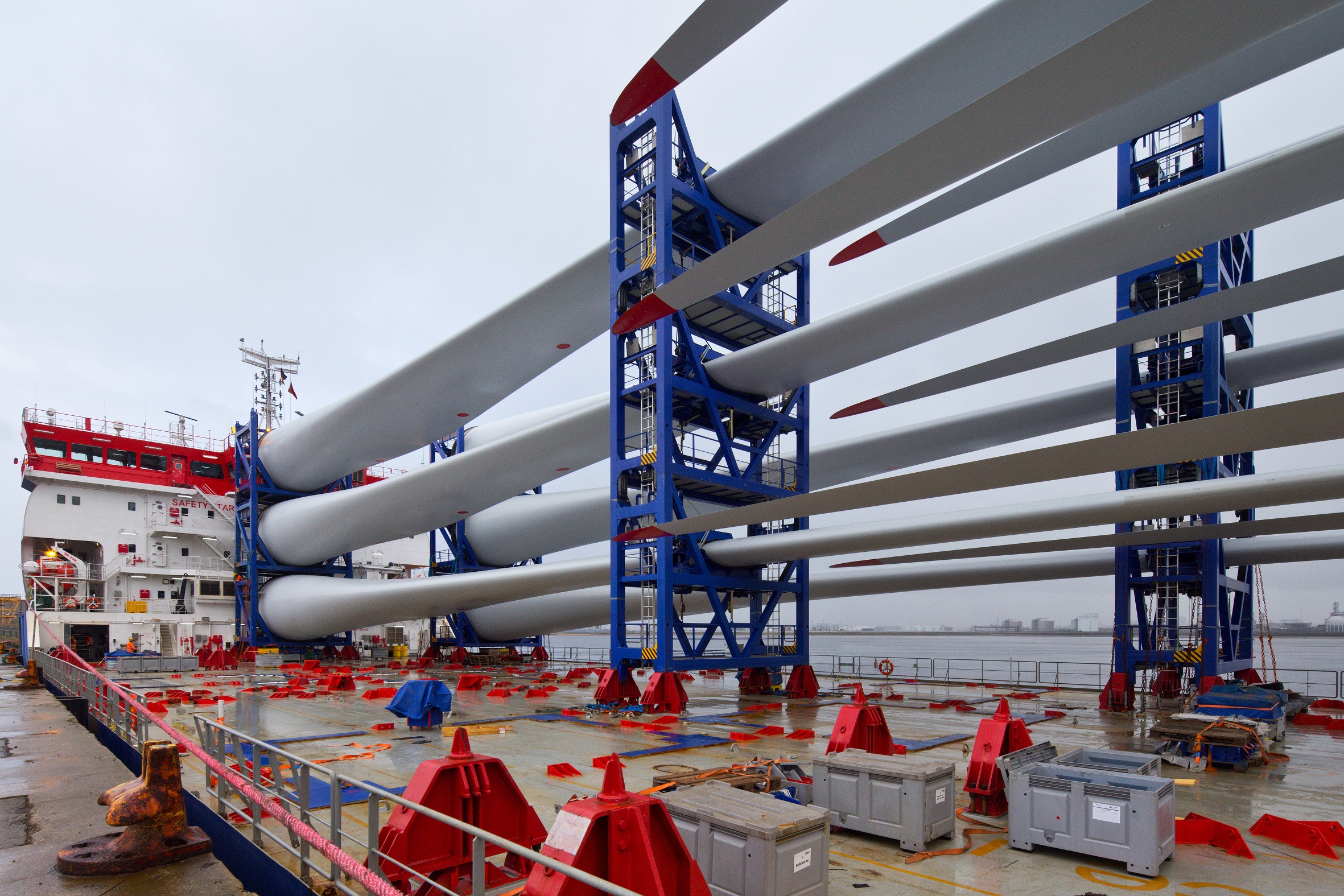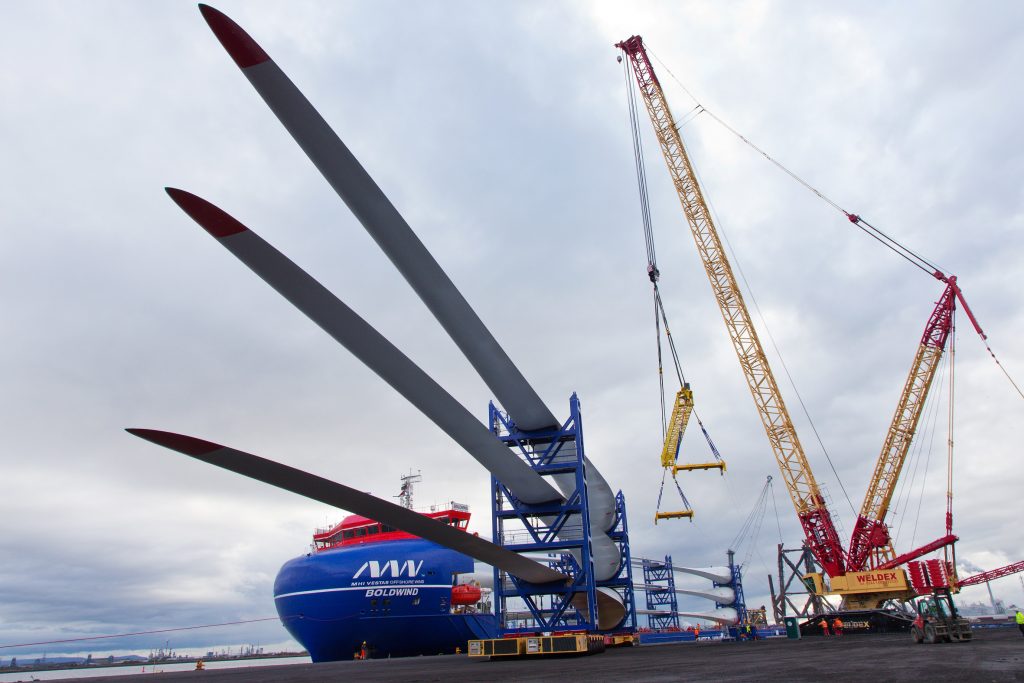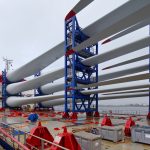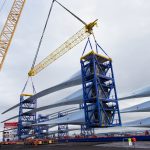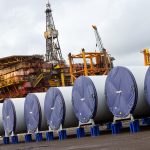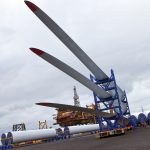- Triton Knoll investment enables port transformation
- Seaton welcomes first ever turbine components to site
- All 15 blades to arrive are manufactured by MHI Vestas in the UK
Triton Knoll is marking a series of project ‘firsts’ as turbine blades destined to be installed at the 857MW offshore wind farm, arrive at its chosen construction port in Teesside.
Able Seaton Port, near Hartlepool, is receiving offshore wind turbine components for the first time in its history, after a combined multi-million pound investment has helped transform the port into a specialist assembly and construction facility for use on the project by turbine supplier MHI Vestas Offshore Wind.
Triton Knoll, which is being constructed by RWE, will install and operate 90 MHI Vestas state-of-the-art V164-9.5 MW turbines, each stretching 164 metres tip to tip, and capable of powering a typical home for up to 29 hrs with a single rotation of its 80 metre long blades.
The first 15 turbine blades to arrive at the port were manufactured by MHI Vestas at its Isle of Wight UK facility and finished at its Fawley plant across the Solent.
Julian Garnsey, Project Director for Triton Knoll and RWE Renewables, said: “Triton Knoll has made a significant investment into Able Seaton Port to establish wind turbine handling facilities there for the first time. It’s an investment that secures the North East of England at the very heart of the delivery of Triton Knoll, and which leaves a lasting legacy for future offshore wind farm projects to be constructed from the region.
“At Triton Knoll we remain committed to ensuring that our investments from this flagship project benefit local coastal communities, and the UK’s expanding offshore supply chain as much as possible. We are delighted to be working with MHI Vestas and Able UK delivering this new UK infrastructure, and to see the first Triton Knoll components arriving at Seaton, ready to begin installation early next year.”
MHI Vestas recently moved onto the 140,000 sq metre Able Seaton Port, where it is establishing a full turbine logistics and pre-assembly hub for the RWE-managed joint venture project.
During its site preparations, MHI Vestas has prioritised UK companies in the delivery of the project. ASP now hosts technicians on-site from local suppliers, including Global Wind Service (GWS), Dawson and Boston Energy, as well as MHI Vestas employees. The main crane and Self-Propelled Modular Transporter (SPMT) to be used at ASP for moving turbine components will be supplied by Weldex, based out of Alfreton, UK. Finally, site stevedoring services are supplied by Able.
MHI Vestas Project Director Torben Damsgaard said: “We are proud that first components, including our blades from the Isle of Wight, for the V164-9.5 MW turbines have now been delivered to the pre-assembly site at Able Seaton. Our V164 turbines are currently the largest turbines installed in commercial projects in the world, and the 80m blades to be used at Triton Knoll will be the largest blades installed in UK waters.
MHI Vestas is committed to the UK, as not only are these world-leading blades produced in the UK, but the Triton Knoll project as a whole is bringing substantial value to local communities. The successful preparation of the Able Seaton site has been one key value driver, as the joint effort by AbleUK and MHI Vestas to prepare the site will pay dividends to the Teesside region as an offshore wind hub for the present and future.”
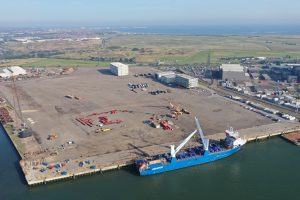
Able’s transformation of the site is a clear sign of its intent for the future as the facility, renowned for end-of-life handling of oil and gas platforms, is gearing up for a future supporting the renewable energy industry. It began the transformation of ASP ready for Triton Knoll in November 2019, and has established a 140,000 sq metre handling facility with specialist quayside, complete with roads and utilities infrastructure, accommodation and office units for those working on site.
Peter Stephenson, Able’s Executive Chairman said: “There is no doubt in my mind that offshore wind is fast becoming a key element not only in terms of clean power generation, but also as a major factor that will drive the whole economy forward. The UK has the biggest market and our combined task is to seek to maximise local content and activity. We play our part by developing specialist future-proofed facilities that meet the demanding needs of our customer.”
The state-of-the-art Triton Knoll offshore wind farm will have a maximum installed capacity of 857 MW and, once fully operational, will be one of the three largest offshore wind farms in the world, capable of powering the equivalent of over 800,000 UK homes(1).
The project is located over 32 kilometres off the Lincolnshire coast, with a turbine array that covers an area of 145 square kilometres, bigger than the City of Manchester. It is jointly owned by RWE, J-Power and Kansai Electric Power, with RWE managing the wind farm’s construction and long-term operation and maintenance works, on behalf of its project partners.
Energy Generation
It is estimated that the average annual generation expected at the site could be equivalent to the approximate domestic needs of an expected minimum of 800,000 average UK households. Energy predicted to be generated by the proposal is derived using wind speeds monitored in the local area and correlated with long term reference data. The energy capture predicted, and hence derived homes equivalent figure may change as further data are gathered. Equivalent homes supplied is based on an annual electricity consumption per home of 4100 kWh. This figure is supported by recent domestic electricity consumption data available from The Digest of UK Energy Statistics and household figures from the UK National Statistics Authority.

